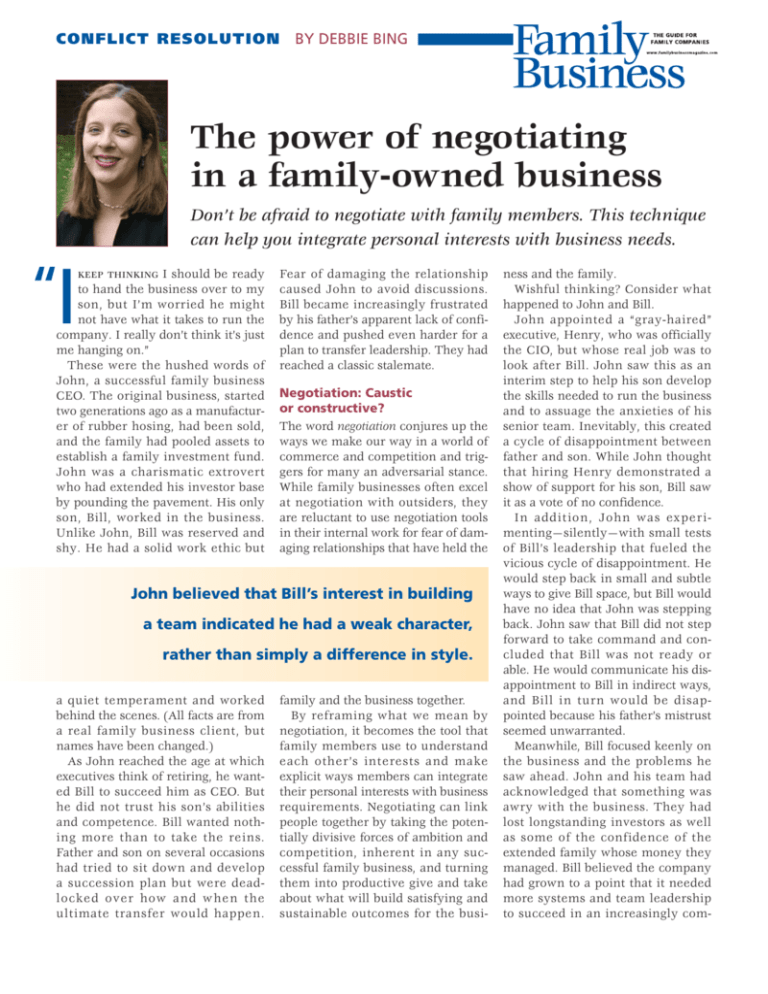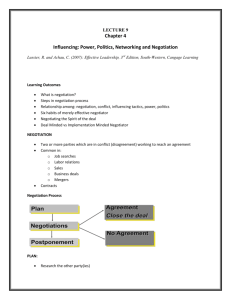The power of negotiating in a family-owned business
advertisement

C O NF L I C T RESOL U TION BY DEBBIE BING The power of negotiating in a family-owned business Don’t be afraid to negotiate with family members. This technique can help you integrate personal interests with business needs. “I KEEP THINKING I should be ready to hand the business over to my son, but I’m worried he might not have what it takes to run the company. I really don’t think it’s just me hanging on.” These were the hushed words of John, a successful family business CEO. The original business, started two generations ago as a manufacturer of rubber hosing, had been sold, and the family had pooled assets to establish a family investment fund. John was a charismatic extrovert who had extended his investor base by pounding the pavement. His only son, Bill, worked in the business. Unlike John, Bill was reserved and shy. He had a solid work ethic but Fear of damaging the relationship caused John to avoid discussions. Bill became increasingly frustrated by his father’s apparent lack of confidence and pushed even harder for a plan to transfer leadership. They had reached a classic stalemate. Negotiation: Caustic or constructive? The word negotiation conjures up the ways we make our way in a world of commerce and competition and triggers for many an adversarial stance. While family businesses often excel at negotiation with outsiders, they are reluctant to use negotiation tools in their internal work for fear of damaging relationships that have held the John believed that Bill’s interest in building a team indicated he had a weak character, rather than simply a difference in style. a quiet temperament and worked behind the scenes. (All facts are from a real family business client, but names have been changed.) As John reached the age at which executives think of retiring, he wanted Bill to succeed him as CEO. But he did not trust his son’s abilities and competence. Bill wanted nothing more than to take the reins. Father and son on several occasions had tried to sit down and develop a succession plan but were deadlocked over how and when the ultimate transfer would happen. family and the business together. By reframing what we mean by negotiation, it becomes the tool that family members use to understand each other’s interests and make explicit ways members can integrate their personal interests with business requirements. Negotiating can link people together by taking the potentially divisive forces of ambition and competition, inherent in any successful family business, and turning them into productive give and take about what will build satisfying and sustainable outcomes for the busi- ness and the family. Wishful thinking? Consider what happened to John and Bill. John appointed a “gray-haired” executive, Henry, who was officially the CIO, but whose real job was to look after Bill. John saw this as an interim step to help his son develop the skills needed to run the business and to assuage the anxieties of his senior team. Inevitably, this created a cycle of disappointment between father and son. While John thought that hiring Henry demonstrated a show of support for his son, Bill saw it as a vote of no confidence. In addition, John was experimenting—silently—with small tests of Bill’s leadership that fueled the vicious cycle of disappointment. He would step back in small and subtle ways to give Bill space, but Bill would have no idea that John was stepping back. John saw that Bill did not step forward to take command and concluded that Bill was not ready or able. He would communicate his disappointment to Bill in indirect ways, and Bill in turn would be disappointed because his father’s mistrust seemed unwarranted. Meanwhile, Bill focused keenly on the business and the problems he saw ahead. John and his team had acknowledged that something was awry with the business. They had lost longstanding investors as well as some of the confidence of the extended family whose money they managed. Bill believed the company had grown to a point that it needed more systems and team leadership to succeed in an increasingly com- CO NFLICT RES O LUT IO N petitive money management and investment world. It could no longer rely on the charisma of a single leader. He suggested creating new team configurations and infrastructure, motivated by his view that a different kind of leadership and management was needed to respond to customers’ growing expectations. John interpreted this as further evidence of Bill’s weakness. Why wasn’t he following in the path that John had created? Without the basis for a productive conversation about the future, it was difficult to make progress on a strategy to advance the business into the next generation. It all looked personal, and the future looked bleak. The power of differences John believed that Bill’s interest in building a team indicated he had a weak character, rather than simply a difference in style. Negotiation facilitates succession by acknowledging that differences—in interests, style and expectation—are natural. Bill was doing what we have seen in many second-generation businesses: creating systems and teams to sustain the business when a charismatic founder leaves. The founder can’t understand this because he or she leads through the force of personality and intuition. We introduced Bill and John to a well-researched conflict style assessment that gives individuals scores across a spectrum of styles—labeled “competitive,” “accommodating,” “compromising,” “collaborative” and “avoiding”—each with its own applications and challenges. The instrument serves as one way to break out of the stereotypes that often pervade family relationships—“he’s just not good at leading,” “she’s not capable of listening to anyone”—and have a discussion about the way different styles come into play in leadership. Given the stark difference between John and Bill’s styles, this tool was the first step at getting unstuck. The assessment result created an “aha” moment—differences can be acknowledged and honored and the other person is not necessarily flawed. John and Bill agreed to work on a succession plan as a negotiation. They talked concretely about what style various business situations demanded and considered what Bill needed to do to take the reins. As John realized that Bill could be successful without being just like him, he saw how they had gotten stuck. This freed them up to look at the business more objectively. He even “Fine,” he said. “Keep doing things your way. But don’t be surprised when your customers continue to hire our competitors because you haven’t responded.” As Bill left the room, John looked through the documents with surprise. “I didn’t know he had done all this work,” John said. “Now I understand why he keeps talking about teams.” This was a breakthrough moment. Bill demonstrated his thoughtfulness John’s lieutenants, once skeptical about Bill’s abilities, watched with increasing confidence as the two hammered out the details and debated vigorously about their points of view. began to see how Bill’s style and instincts could benefit the business. For example, faced with a threatening market evolution, John naturally turned to what had made the business successful so far: aggression and personal charisma. But Bill had a different point of view about what was needed. He had reviewed recent customer surveys and found that many long-term customers questioned the consistency and responsiveness of the service department. Clients were satisfied with the kind of investment opportunities offered by the firm, but they had become more sophisticated in their expectations about ongoing tracking and monitoring of their investments, and they knew they had other choices. They questioned whether John’s business had developed the infrastructure to serve their ongoing needs. Bill believed that new systems, linking the parts of the business together, would distinguish them in the future. This transition wasn’t without its bumps, of course—negotiation never is. At a tense meeting, feeling that his father would never trust him, Bill headed for the door and threw down the pile of customer evaluations and the work plan he had developed. as well as his mettle. They began exploring alternative ways of running the business. John’s lieutenants, once skeptical about Bill’s abilities, watched with increasing confidence as the two vigorously debated their points of view. “If Bill can take his father on,” they marveled, “then he must have more gumption than we thought.” Today, Bill runs the company, which has grown in large part because of the introduction of a new approach to online service. John has just about retired. The business and the family are doing well. Succession challenges all family businesses. Negotiation tools bring family members closer together by depersonalizing, even harnessing, differences. By reframing negotiation from an adversarial strategy to a structured, tool-based process that builds relationships, you can devise durable agreements for the family and the business for generations to FB Q come. Debbie Bing is a principal at CFAR, a management consulting firm that helps organizations improve performance, with offices in Philadelphia and Boston (www.cfar.com). Reprinted from Family Business Magazine® Autumn 2008 © Family Business Publishing Company • 1845 Walnut Street, Suite 900 • Philadelphia, PA 19103 (215) 567-3200 • www.familybusinessmagazine.com






